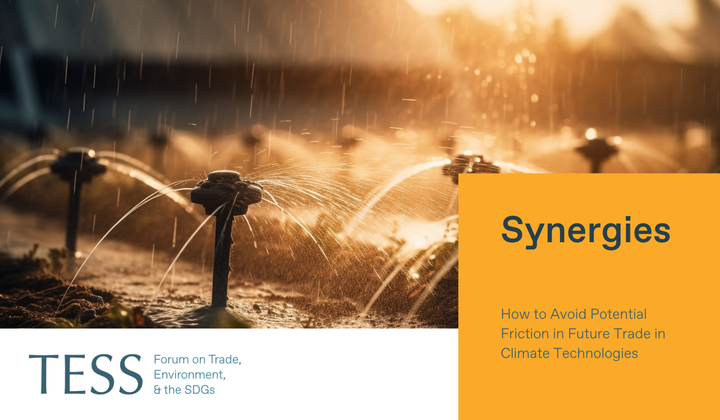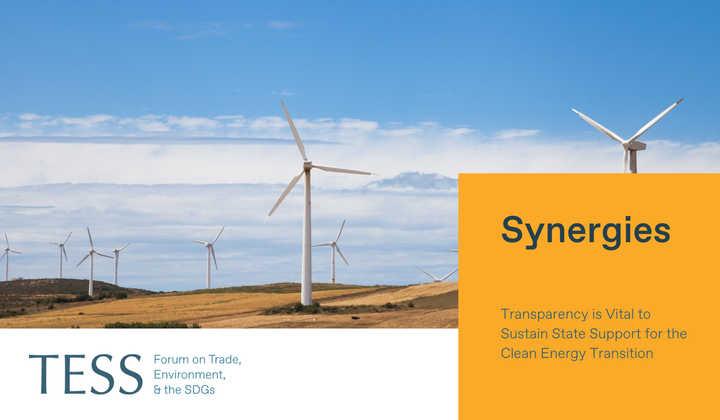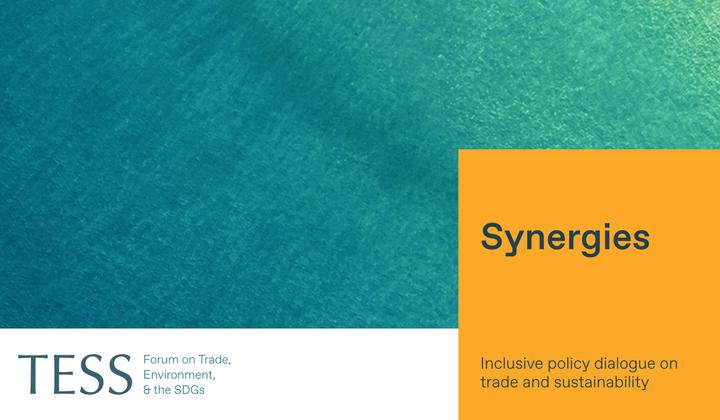The World Trade Organization (WTO) like other multilateral institutions is facing many challenges. Yet, it is vital that countries find ways to engage with each other on boosting green economic activity and trade. The WTO can be an effective forum for knowledge exchange and working through complex issues. WTO members may not be ready to build a “green WTO”, but there are already many practical steps they can take to collaborate through the institution to make trade for the green economy easier.
This article is part of a Synergies series on reviving multilateralism curated by TESS titled From Vision to Action on Trade and Sustainability at the WTO. Any views and opinions expressed are those of the author(s) and do not necessarily reflect those of TESS or any of its partner organizations or funders.
-----
WTO members will gather at a ministerial level from 26–29 February in Abu Dhabi, United Arab Emirates. The meeting comes at a challenging time for global trade and multilateralism generally. It’s also a difficult time for efforts to green economies. The recent UN climate gathering in Dubai last November highlighted that countries’ climate mitigation efforts are falling short. Progress is being made in some places, but implementing the net-zero transition is no easy task. Traditional industries need new technologies, new technologies demand new supply chains and skills, far greater finance is required, and much more carbon content mapping must be conducted. The rubber truly has started to hit the road for governments, workers, companies, and consumers alike.
Why should WTO members take an interest in these debates? There are at least three reasons:
1. A Rules-Based Trade System is Needed for Climate Action
The WTO is the backbone for international, rules-based commerce. Sure, its dispute settlement function is threatened. But the organization is still a powerful source of rules and norms for the way countries regulate goods, services, and investment moving across borders. Companies appreciate that. In recent debates around the green transition and economic support, or on supply chain resilience, few executives suggest that a rules-based system needs to be upended. There is a general recognition that trade can help the world combat climate change and biodiversity loss, through spreading innovations and generating economies of scale for new technologies, among other things.
However, many companies would like to see WTO members work together for more consistency on subsidy rules—including working to phase out fossil fuel subsidies—or to address slow permitting processes for foreign investment in renewable energy projects. These wishes need to be balanced with countries’ interests and debated, which leads us to the next point.
In recent debates around the green transition and economic support, or on supply chain resilience, few executives suggest that a rules-based system needs to be upended.
2. Conversation is Helpful
The green transition is taking place against a period of geopolitical turbulence. One has not caused the other, but the two are related, and will likely become more intertwined in the future. Further, if not wisely navigated, trade could hinder individual countries’ efforts to combat climate change through offshoring emissions. Equally, the industrial transition needed to combat climate change creates competitive and protectionist dynamics which might also undermine climate action in the long run.
The Forum has mapped four future scenarios for trade and climate change to think through potential trends. According to our consultations around the scenarios, avoiding an “exponential disasters” scenario where climate policies precipitate trade wars—flanked by resource nationalism—can be helped by government discussions in a few areas. One of these is carbon accounting and reporting standards. These have proliferated, and may continue to do so, creating an uneven landscape on which countries will inevitably base trade policies.
Japan’s G7 effort in 2023 around emissions measurement methodologies for a net-zero steel industry was a good push; these discussions need to be brought into wider international fora. Countries could use the WTO for exchange, or at least for sharing knowledge on key developments occurring in this space. Building up wider government knowledge and building institutional bridges ultimately helps the private sector deal with a less fragmented landscape.
3. Facilitate the Green Economy
Companies really like the WTO Trade Facilitation Agreement (TFA). It addresses practical challenges that occur on a daily basis when goods are moved across borders. Through initiatives such as the Global Alliance for Trade Facilitation (GATF), companies have also been able to work with governments on implementing the TFA, homing in on specific difficulties and working to address them.
WTO members should use the institution to look at ways they can facilitate green economic activity. Of course, “facilitation” can mean different things to different people. For some WTO members, there might be appetite to apply the proposed Investment Facilitation for Development agreement to focus specifically on climate-aligned capital flows. The Forum is already working with investment promotion agencies in Brazil and Namibia on actions to facilitate climate foreign investment into their economies. Targeted investment facilitation on climate-aligned invest projects can be a helpful way to ground investor interest in climate action into specific country needs and activity.
For other WTO members, it could mean working to boost goods and services trade essential for low-carbon economic activity. There are some politically sensitive products in this space—like electric vehicles—but there are also other items where non-tariff barriers like conformity assessment procedures and different technical requirements slow down market growth and vital technology diffusion. The Trade and Environment Sustainability Structure Discussions (TESSD) have made a good start in digging into these issues. For example, static converters used to convert solar energy to electricity face 523 technical requirements applied by 61 different countries. These requirements may be important and do not necessarily need to be eliminated, but governments could work on regulatory cooperation to maintain the outcome and reduce trade friction.
WTO members can look at how existing tools like trade facilitation can be applied to environmental challenges.
WTO members can even look at how existing tools like trade facilitation can be applied to environmental challenges. Improving waste management and material recycling in some countries might require trade. Countries need to track waste movement to avoid trade being used for dumping. This is all covered by the Basel Convention, but as an environmental treaty, policymakers there could benefit from border expertise and new developments that make managing the process of trade easier. The GATF has worked with the International Plant Protection Committee to help countries roll out digitalized phytosanitary certificates for safe plant and food trade. Could WTO members encourage the same type of collaboration with relevant fora for more material circularity?
These are not necessarily topics or work that make headlines. Nor are they a package for a “green WTO”. Members are not there yet; they may not be for some time. But business models that are low-carbon, based on reusing and surfacing alternative materials, and that have nature-positive outcomes are worth encouraging. Trade has a role to play in these new economic activities, and the WTO is a good avenue for countries to collaborate through.
-----
Kimberley Botwright is the Head of Sustainable Trade at the World Economic Forum.
-----
Synergies by TESS is a blog dedicated to promoting inclusive policy dialogue at the intersection of trade, environment, and sustainable development, drawing on perspectives from a range of experts from around the globe. The editor is Fabrice Lehmann.
Disclaimer
Any views and opinions expressed on Synergies are those of the author(s) and do not necessarily reflect those of TESS or any of its partner organizations or funders.
License
All of the content on Synergies is licensed under a Creative Commons Attribution-NonCommercial-ShareAlike 4.0 International (CC BY-NC-SA 4.0)
license. This means you are welcome to adapt, copy, and share it on your platforms with attribution to the source and author(s), but not for commercial purposes. You must also share it under the same CC BY-NC-SA 4.0 license.
If you would like to reuse any material published here or if you have any other question related to Synergies, send an email to fabrice.lehmann@graduateinstitute.ch.




